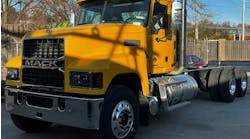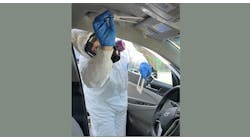I admit that I am behind the curve when it comes to diesels. Come check out what I learned!
I've worked on gas-powered passenger cars and light trucks for the majority of my 35 years under the hood. There was the occasional large people mover, and I've turned a wrench on nearly everything else that runs on gasoline at one time or another, from lawn mowers to airplanes.
But when it comes to diesels, the most I've ever done on the powerplant was an oil change or fuel filter replacement.
To say I'm behind the curve here is an understatement. But I have a feeling I'm not the only one out there. With diesels growing in popularity, I guess it's about time you and I both learn a bit more on how these things do what they do.
A Little History
What do you think of when you hear the word "diesel"? I always picture a large Peterbilt or Kenworth, hauling its heavy load down the highway, black smoke spewing from the exhaust stacks with every gear change.
Diesel engines are also known as compression-ignition engines, or engines that use the heat of compression to ignite the fuel mixture — rather than rely on an external ignition source like a gasoline engine does. The idea for the diesel engine was patented on Feb. 23, 1892, in a patent application titled "Method of and Apparatus for Converting Heat into Work" by Rudolf Diesel. He built his first working prototype in 1893.
Diesel designs were popular for marine applications, where the low-speed, high-torque engines excelled and the weight of the powerplant was a secondary concern. They quickly gained ground in other applications, and even began making their way into passenger cars by the early 1930s.
Because of their efficiency advantages (and resulting fuel economy), nearly half of the cars sold in Europe today are diesel-powered. Here in the U.S., though, most consumers shy away from diesel offerings, thinking only of the black smoke and noisy knocking typically associated with them. That may change: Modern designs have all but eliminated these character flaws, as engineers strive to meet increasingly stringent emissions requirements.
Basic Theory
Compression-ignition engines differ from their spark-ignition counterparts in a fundamental way. Like me, you're likely used to the idea of a spark plug igniting the air/fuel mixture. Diesels use the heat of the air charge to do the igniting. They are able to raise the temperature of the air charge by using a substantially higher compression ratio.Be sure to read up on the operation of the high-pressure side before you do any service work! They can produce several thousand pounds of fuel pressure, and can hurt you if you don't follow the OE procedures for testing.
Types of Injection
There are four basic injection systems you may find yourself dealing with when diagnosing diesel complaints. But considering there is no ignition system in the equation, many drivability issues will be fuel-related:
1. Common rail system: In this design, the high pressure needed to feed the direct injection system is produced by the injection pump and delivered to the individual injectors along a single tube, or rail, similar to spark-ignition multiport injection systems.2. Hydraulic Electronic Unit Injection (HEUI): In the HEUI system, fuel is delivered to the injectors at approximately 50 to 70 psi of pressure. The injectors themselves are powered by oil, pressurized by a separate pump. This oil is sent to the top of the injectors at pressures nearing 3,000 psi, and acts on a plunger, below which is the waiting fuel charge. The high-pressure oil forces the plunger/stopper down against the fuel similar to a medical syringe, multiplying the pressure of the fuel charge to the needed levels. Hard starts on these can be caused by something as simple as a low oil level, or fuel in the oil.
3. Electronic Unit Injection (EUI): Similar to HEUI, a plunger-style injector is used to force the fuel into the pressurized combustion chamber. But in the EUI system, rocker arms and the camshaft mechanically operate the plungers. Because of this, adjusting the lash between the rocker and injector may be necessary, so check that service information.
4. Pump-Line-Nozzle Injection (PLN): Also known in VW circles by its German name, Pumpe-Düse (literally, pump-nozzle), a high-pressure pump is used to generate the pressure needed. It feeds that high-pressure charge through individual lines to injection nozzles located on the cylinder head.
Diagnostic Tips
The California Air Resources Board (CARB) and Environmental Protection Agency (EPA) began requiring that light-duty diesel vehicles be OBD II compliant back in 1997, but it wasn't until 2007 that the requirement was expanded to include diesels with Gross Vehicle Weight Ratings (GVWR) between 8,500 and 14,000 lbs.Burned-out glow plugs can also lead to cold start/hard start issues, and are easily tested using an ohmmeter. Failed glow plugs can also cause white smoke to be present in the exhaust the first few minutes after start-up. One tech recently wrote me to share that he uses glow plug resistance while running to locate misfiring cylinders!
Speaking of white smoke, the color white is indicative of a lean condition. Water in the combustion chamber of a diesel will cause steam in the exhaust stream. Black smoke is generally a sign of excess fuel in a diesel; blue smoke is a sign of oil entering the combustion chamber. Because nearly every diesel on the road is equipped with a turbo, leaking turbo seals could be the cause.
There is a lot more to learn for both of us, but that's all the space we have for now. If you're new to diesels, you can always log on to MotorAge.com, join the community, and have access to all the resources Motor Age and our community partners have to offer. See you there!
Sidebar 1: Diesels on the racetrack
Nearly every conceivable version of the internal combustion engine has made its way to the Indy 500. But it was a 1931 entry of a rather unusual type that made it into the record books as the first to complete the entire 500-mile race without a pit stop.
That entry wasn't a new gasoline design, nor did it use an exotic fuel. Driven by Dave Evans, it was a Cummins Diesel Special. The car was never expected to be competitive, and was allowed to enter as a "special engineering" entry — as long as it could post at least a 70 mph lap average.
The Cummins Special did better than that, qualifying at 96.871 mph and posting a post-race total for fuel and lubricant expense of only $2.40. That's only $32.67 in today's dollars!
Diesels have made themselves known in other racing arenas since then. In the late '70s, Mercedes-Benz drove a five-cylinder design to several new records. With turbocharged diesels gaining strength by the '90s, more began competing in the touring car scene — with BMW winning the 24 Hours of Nürburgring in 1998 with a 320d. In 2002, a Cummins-powered truck hit the Bonneville Salt Flats, and became the world's fastest pickup with a top speed of 222 mph. It even towed its own support trailer to the Flats!
Le Mans, Formula 1, drag racing — nearly every motorsport (except NASCAR) has seen diesel-powered entries establish new records and win races. It's only a matter of time before this venerable powerplant wins over the respect of the average consumer in the U.S., the same as it has buyers in other parts of the world.
Sidebar 2: Add A9
To be certified as an ASE Master Automotive Technician, you need only to complete the A1 through A8 certification exams. But with the increase in passenger and light truck diesel vehicles (and the corresponding growth in potential customers) on the road, you may want to consider adding a ninth: A9, ASE's Light Vehicle Diesel Engines certification.
Now is also a great time to do it. With ASE's move over to CBT (computer-based testing), you can schedule your exam nearly any time you want, rather than wait for one of the two three-day paper-and-pencil testing dates. The new two-month on/one-month off testing cycle also provides you immediate results when you're done. For more information or to register for the Winter testing session, log on to www.ASE.com. Don't forget to activate your myASE account while you're there.
Preparing for the exam is easy, too. The Motor Age series of ASE study guides are among the most comprehensive in the business, and we'll even guarantee you'll pass. Available in print or online subscription, you can get all the details at www.PassTheASE.com.
Illustrations (Waiting on MAT or A9 illustration from marketing)
Sidebar 3: Getting the sulfur out
Today's diesels have to meet the same emissions standards as their gas counterparts do. We've told you about various ways the manufacturers are cutting down the two most prevalent diesel emissions problems, nitrogen oxides and particulates. A major hindrance to using catalytic converters and particulate filters to control these emissions, though, had been the sulfur content of the fuel itself.
Now, Ultra-Low Sulfur Diesel fuel is required for use in diesel powerplants made after 2007. ULSD contains less than 15 parts per million of sulfur, allowing the use of today's advanced diesel emissions technology.



